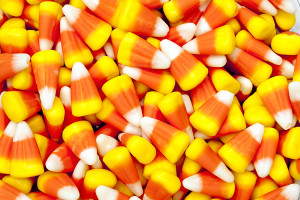 In the 1880s, when 50% of the American population was farming, most of the chicken and pig feed was corn. Before World War I, most people did not eat corn because there was no rationing and hybrid sweet corn was not discovered yet. Now you are asking yourself, “What does this have to do with candy?” Well, George Renninger worked at Wunderlee Candy Company in Philadelphia, Pennsylvania and he came up with an idea for penny candy. He called it “chicken feed” because it looked like the corn kernels the children fed the farm animals. The original candy corn recipe included sugar, fondant (a mixture of creamy icing), corn syrup and water. It was labor intensive, so large kettles were used to make up the different candy color mixtures by hand. Wooden molds were used to form the candy, and the workers would pour one color at a time into the molds. After 24 hours, the candy was ready to be taken out of the molds and packaged in bulk. It was hard and tedious labor when you consider the size of the candy kernel. Because of the time involved in making the candy it was only available from March through November. Wunderlee Candy Company became Goelitz Candy Company and eventually Jelly Belly Candy Company. In the 1920s, the advertising used a picture of a rooster crowing and declaring “Something worth crowing for… Goelitz Butter Sweet Candy Corn.” During the first half of the 20th century, children and adults bought the penny candy and would take it home in a paper sack. With the advent of machines, it was much easier to mass produce the candy. The recipe has not changed in over 100 years. In the 1950s, trick-or-treaters going from door to door on Halloween became popular and boosted the sales of the famous Halloween treat. It was greatly advertised – so much so that candy corn became synonymous with Halloween. October 30th is officially known as National Candy Corn Day. Of course, with the advent of modern machinery, candy corn is now available year-round and there are even special colors for various holidays. But the tri-colored candy that was patterned after chicken feed is still the Halloween favorite. Today, approximately 9 billion pieces are made each year, which equates to 35 million pounds. Apparently, it still satisfies the sweet tooth, it is fat free and a hand full of kernels are approximately 140 calories. So, if you happen to walk by your child’s Halloween haul and it looks tempting, it is okay – do not feel guilty. When no one is looking, grab a quick handful and enjoy. I guarantee you will walk away with a smile on your face, a great taste in your mouth and memories of Halloween past.
In the 1880s, when 50% of the American population was farming, most of the chicken and pig feed was corn. Before World War I, most people did not eat corn because there was no rationing and hybrid sweet corn was not discovered yet. Now you are asking yourself, “What does this have to do with candy?” Well, George Renninger worked at Wunderlee Candy Company in Philadelphia, Pennsylvania and he came up with an idea for penny candy. He called it “chicken feed” because it looked like the corn kernels the children fed the farm animals. The original candy corn recipe included sugar, fondant (a mixture of creamy icing), corn syrup and water. It was labor intensive, so large kettles were used to make up the different candy color mixtures by hand. Wooden molds were used to form the candy, and the workers would pour one color at a time into the molds. After 24 hours, the candy was ready to be taken out of the molds and packaged in bulk. It was hard and tedious labor when you consider the size of the candy kernel. Because of the time involved in making the candy it was only available from March through November. Wunderlee Candy Company became Goelitz Candy Company and eventually Jelly Belly Candy Company. In the 1920s, the advertising used a picture of a rooster crowing and declaring “Something worth crowing for… Goelitz Butter Sweet Candy Corn.” During the first half of the 20th century, children and adults bought the penny candy and would take it home in a paper sack. With the advent of machines, it was much easier to mass produce the candy. The recipe has not changed in over 100 years. In the 1950s, trick-or-treaters going from door to door on Halloween became popular and boosted the sales of the famous Halloween treat. It was greatly advertised – so much so that candy corn became synonymous with Halloween. October 30th is officially known as National Candy Corn Day. Of course, with the advent of modern machinery, candy corn is now available year-round and there are even special colors for various holidays. But the tri-colored candy that was patterned after chicken feed is still the Halloween favorite. Today, approximately 9 billion pieces are made each year, which equates to 35 million pounds. Apparently, it still satisfies the sweet tooth, it is fat free and a hand full of kernels are approximately 140 calories. So, if you happen to walk by your child’s Halloween haul and it looks tempting, it is okay – do not feel guilty. When no one is looking, grab a quick handful and enjoy. I guarantee you will walk away with a smile on your face, a great taste in your mouth and memories of Halloween past.
Previous ArticleA Show To Remember
Next Article Everything At ATA Is “Hecho En USA”
SharLeigh
SharLeigh has an inquisitive nature – she is interested in current events, history, science and many more subjects, including things that go bump in the night! Since 1997, SharLeigh has scoured the internet, looking for interesting, fun and timely topics covering all sorts of human-interest subjects for her articles from her home in Fontana, CA.
